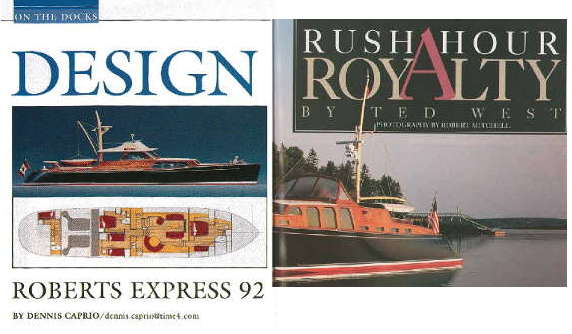Express 92
Design Review--Yachting Magazine
- Download:

- "On the Docks: Roberts Express 92", Denis Caprio, Yachting, September 2002
Roberts developed the Express 92 from Liberty, an 80 footer he designed toward the end of a 14-year stint at BKYD. Built in cold-molded wood by Hodgdon Yachts, she was launched in 1996 ("Rush Hour Royalty," June 1997 PDF Yachting review of Liberty). Although Roberts scaled up Liberty to arrive at the Express 92, significant differences separate these siblings. In the process of scaling up, the proportions remain the same as the boat grows exponetially in volume. For example, Liberty's length-to-beam ratio is 5.32 (beam is 18 percent of her length); the Express has a ratio of 4.8 (beam is 20 percent of her length). These numbers seem fairly close, belying the considerable increase of interior volume the larger yacht enjoys. Liberty's owners cared little for interior volume, but Roberts wanted to provide accommodations closer to what a yachtsman would get from a 92-footer of conventional proportions. A typical 92-foot motoryacht would have a beam of 20 to 22 feet. I envy the client who commissions this design to completion. If I were that yachtsman, I would build her as drawn and bask in the attention she attracted in every harbor.
Similar Designs
Designer's Comments
The 92 Express is a scaled up sister hull to my previous design Liberty, done while at Bruce King Yacht Design. Liberty is of cold-molded wood construction, built by Hodgdon Yachts and launched in 1996. Her design was based on the Long Island Sound commuters of the 1920's and 30's, specifically on Saga, a 69 footer built by Wheeler Shipyard in Brooklyn and launched in 1935. Liberty borrows from Saga her general profile and arrangement, but beyond that all is new; hull form, construction, power, and systems are all completely up to date.
Liberty is long and narrow, 80 foot by 15 foot, which fits the owner's requirement for superior performance and looks, with interior volume a secondary consideration. These requirements were met; Liberty achieved 32 knots on trials. All who have seen the boat agree that she is stunning. But her accommodation is somewhat minimal for an 80 foot yacht.
The 92 foot Express is an effort to maintain the stunning looks and performance of Liberty while adding the spacious interior expected in a 92 foot motoryacht. In the 92 footer I have increased beam relative to length slightly, from 18% of length in Liberty to 20% in the 92 Express. The 92 footer is still narrow by modern standards; the average is 21 foot-22 foot but this is entirely in keeping with her retro styling and performance objective. With 19 foot of beam her interior spaces take on the feeling of a room, rather than that of a passageway.
The 92's relatively narrow beam will not have any detrimental effect on her stability, because she also has a low profile. Narrow beam also has several advantages for the boat's handling and performance. Long, narrow hulls do not suffer from trimming problems like wider hulls do, and a narrow hull means a finer entry. This produces a fast, easy running and efficient boat. The 92 Express will cruise at between 25 and 30 knots, with a top speed of 33 knots. Power will be twin 1500 DDC/MTU 12V 2000 M91 engines.
Choices for construction material are aluminum, cold-molded wood, or foam cored composite. High quality, light weight boats can be built in all these materials, and each has its advantages. The composite structure is possibly the lightest of the three, aluminum is probably the fastest to build, and the wooden hull would be the stiffest. The cold-molded boat would also offer the most aesthetically pleasing structure.
The arrangement of the 92 Express is intended to provide maximum privacy for all aboard, owner, guests, and crew. Owner and guest staterooms are separated by the main saloon, and crew accommodation is aft of the engine room. Each of these areas has separate access to the deck.
The entire boat forward of the lower saloon is devoted to the owner\u2019s cabin. Farthest forward is the owner's cockpit. At anchor or underway this is a quiet and secluded spot to relax far from the noise and activity that prevails farther aft. Three steps down aft of this cockpit is the owner's cabin. This includes a head divided into two areas, port and starboard, and a full width sleeping cabin. There is a king size walk around double berth on centerline, two hanging lockers, couch, and desk/vanity. Aft to port a staircase leads up to the lower saloon.
The lower saloon is a bright and airy space with large windows port, starboard, and across the front of the deckhouse. Here we have comfortable seating around a small fireplace and a dining area for six. Aft in the saloon are steps up to the command bridge and down to the galley and guest cabins.
The galley and utility area is right at the bottom of the steps from the saloon, so it is handy to both the dining area and the bridge. Going aft past the galley we have two double guest cabins with on-suite heads. These are reasonably spacious and can be set up with either twin berths or a walk around double.
The bridgedeck is the heart of the ship; all operations are overseen from here. Visibility is excellent from the helm on centerline forward. There are Stidd seats for five facing forward, storage and serving areas, and a large lounge with dining table aft. Access to the main deck is through half-doors Port and Starboard and aft is the ladder up to the flying bridge.
The aft cockpit gives access to the crew cabin and mess, forward of this is the engine room. Forward of this again we have fuel tankage forming a sound barrier between the guest cabins and the engines. The propulsion setup will include V-drives and propeller pockets.

